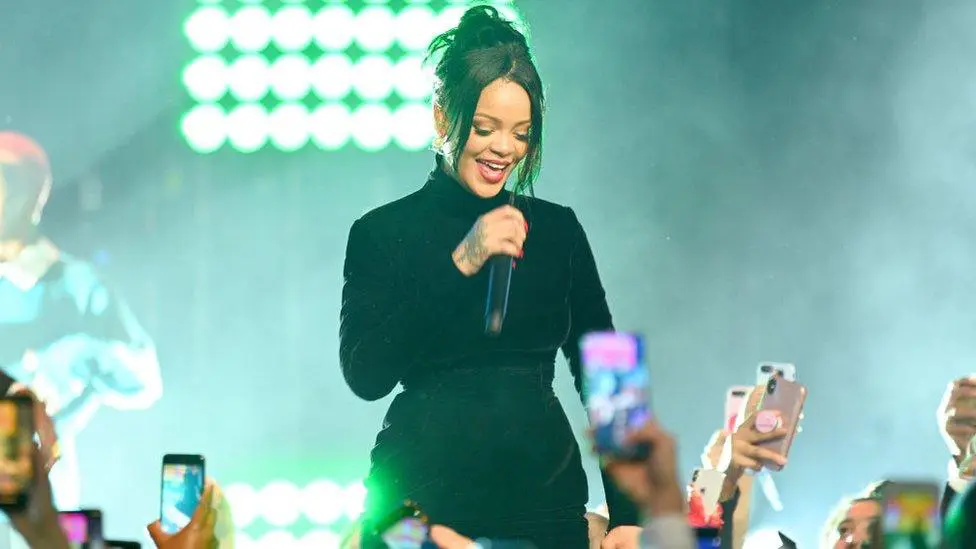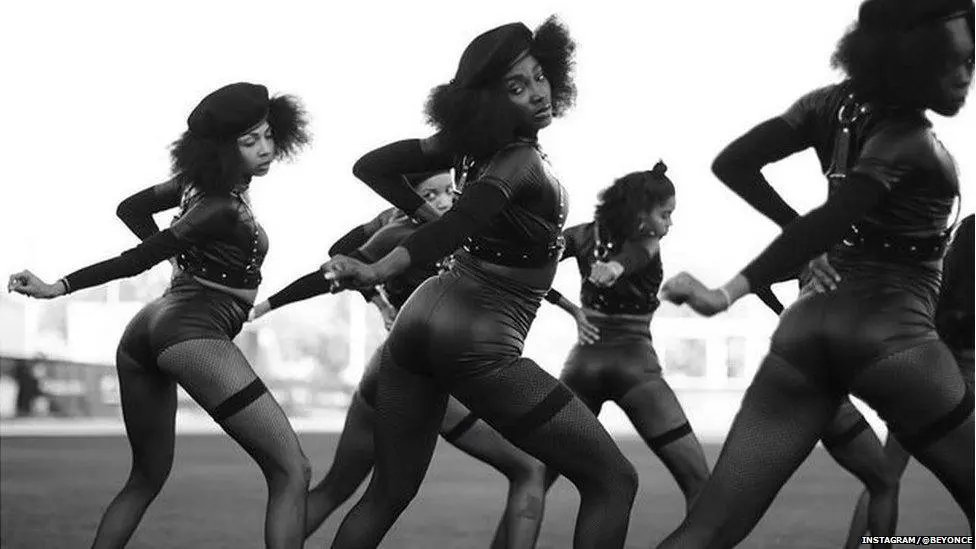The Super Bowl halftime show has always been a platform not just for entertainment, but also for powerful statements. Recently, a dramatic incident involving Kendrick Lamar’s halftime performance stunned audiences. A performer, part of the massive 400-member field cast, unfurled a combined Palestinian and Sudanese flag during the show, creating a ripple effect far beyond the football field. In a bold protest amid the glitz and glamour of the Super Bowl, this unnamed individual captured attention not just for their display, but for the subsequent reaction from the NFL and the public. The league has publicly declared a lifetime ban on this performer from all NFL stadiums and events.
This unusual moment unfolded as Lamar delivered a riveting performance of his song “Not Like Us,” which has become a cultural touchstone in the hip-hop community. The actions of the performer have ignited discussions about the intersection of sports, politics, and cultural expression—a topic that reverberates through the veins of modern society.
A Closer Look at the Super Bowl Halftime Show
The Super Bowl halftime show has morphed into an anticipated event that rivals the game itself. With millions of eyes glued to the screen, artists seize this opportunity not just to entertain but to communicate messages that resonate with their audiences. It’s a significant platform, making it a strategic choice for artists like Lamar, who are known for weaving social commentary into their work.
The halftime show featured a carefully choreographed performance where Lamar was accompanied by a multitude of dancers clad in striking colors, contributing to the visual spectacle. Yet, it was one dancer—breaking from the scripted performance—who commandeered the attention of social media and news outlets.
This incident speaks volumes about the power of expression in a time where athletes and entertainers alike are rejecting the confines of their roles. The performer’s actions underscore a growing trend where individuals in the spotlight leverage their influence to advocate for causes, aligning their artistic expression with social and political movements.

The NFL’s Response and the Aftermath
The NFL’s reaction to the incident has been swift and resolute. A spokesperson confirmed that the organization was unaware of the individual’s intentions prior to the performance. Following the event, a statement revealed that the performer would face a lifetime ban from all NFL-related activities. This decisive action aims to uphold the integrity of the event and maintain the intended entertainment focus of the Super Bowl halftime show.
It’s essential to dissect the implications of this response. The NFL’s stance highlights the organization’s commitment to controlling narratives during high-profile events. However, it raises questions about the limits of artistic expression within commercial platforms. Discussions on social media have erupted, as many applaud the performer’s bravery while others criticize the NFL for taking such a formidable stance.
Commentators suggest that this conflict encapsulates a broader cultural clash—a tension between the desire for artistic freedom and institutional control. Critics argue that banning individuals from expressing their beliefs, especially in a format designed for performance art, may stifle necessary dialogues on pressing global issues.
The Performer’s Message: Context Behind the Protest
The protest sparked by the performer cannot be viewed in isolation; it draws threads from ongoing geopolitical narratives. The flags representing Sudan and Palestine symbolize ongoing struggles and crises that have gained international attention. In a moment saturated with spectacle, the performer’s actions transform an entertainment event into a space of activism, challenging the norm of silence around such issues in mainstream media.
The impact of these struggles reverberates beyond their geographic boundaries, intertwining with broader issues like humanitarian crises, immigration policies, and international relations. By unfurling the flags, the performer not only made a statement about solidarity with those impacted by war but also connected the dots for viewers, urging them to consider the human stories behind the politics.
This bold act acts as a reminder of the role that cultural figures can play in advocacy. As protests and global movements grow in intensity, so does the desire for platforms to elevate voices that demand change. The intersection of culture and social justice is becoming increasingly relevant, calling into question how cultural spheres can exist alongside or challenge political discourse.

The Role of Entertainment in Social Movements
Entertainment has long been a catalyst for social change, and this incident exemplifies how artists today are making conscious choices to intertwine their work with activism. The Super Bowl—a space traditionally reserved for commercial interests—has become an unexpected battleground for voices advocating for change.
Throughout history, performers like Bob Dylan, Nina Simone, and more recently, Beyoncé and Childish Gambino, have used their platforms to comment on pressing societal issues. Kendrick Lamar’s engagement with these themes places him squarely in this lineage of artist-activists, reinforcing the idea that art can provoke thought and inspire action.
This incident isn’t merely a moment of protest but part of a larger movement where artists are pushing the boundaries of their roles. As the tradition of the halftime show evolves, it appears that artists are willing to risk their opportunities for the sake of raising awareness—an indication of a significant cultural shift.
The Public’s Reaction: Mixed Responses
For some, the flags were symbols of resistance, highlighting the plight of marginalized communities. For others, the action disrupted the Super Bowl, an event they viewed as a sacred American tradition meant to be untouched by political sentiments. This clash of opinions presents an interesting dialogue on the place of activism in entertainment.
The conversations unfolding on social media are encouraging people to reflect on what they value in entertainment. Does one’s enjoyment of a performance overshadow the importance of raising awareness about pressing issues? As discussions continue, it’s clear that this performer’s actions have stirred a deeper conversation that reaches well beyond the field.

Navigating the Future: Activism and Entertainment
As activism becomes more prominent within popular culture, the lines between entertainment and advocacy will continue to blur. At events like the Super Bowl, where viewership is immense, artists have the opportunity to elevate issues that may otherwise be overlooked.
The backlash against the performer raises questions about the future for artists willing to engage politically. Will they continue to risk their careers for the sake of their beliefs? The courage exhibited by this performer serves as both an inspiration to some, and a cautionary tale to others.
The NFL’s crackdown may deter future expressions of activism during such events, but it also may fuel a desire among some artists to find ways to navigate their messages without facing immediate backlash. Musicians and entertainers are continually challenged to strike a balance between their artistic integrity and commercial interests.
Broadening the Scope: Future of Activism in Sports and Entertainment
The growing phenomenon of artists using their platforms for activism isn’t confined to the Super Bowl but resonates throughout various spheres of entertainment and sports. As the conversation expands, the implications reach beyond a single performer or event—we’re witnessing a cultural renaissance where artists reclaim their narratives and assert their rights to express dissent.
The dialogue surrounding the Super Bowl protest serves as a microcosm of larger societal debates regarding freedom of expression. How will institutions like the NFL adapt to a culture where activism is increasingly prevalent? Athletes and entertainers are now at a crossroads—some blending artistry with activism while others adhere strictly to entertainment.
As seen in other sports leagues and entertainment platforms, a growing interest exists in examining the role of athletes not just as players but as influential voices in social justice. This shift suggests a potential evolution of how sports and entertainment will approach issues of advocacy moving forward.

Final Thoughts on the Intersection of Sports, Culture and Activism
The Super Bowl halftime show incident surrounding Kendrick Lamar amplifies the critical conversation around the powerful intersection of art, culture, and activism. The actions of an individual performer reflect a broader movement where cultural figures challenge norms and advocate for social change.
Our collective experience—from the responses garnered to the visual momentum of the protest—demonstrates that no event exists in a vacuum. The performer’s bold move highlights how art can catalyze meaningful discussions while simultaneously drawing attention to global issues that demand urgency.
Engagement in activism through performance art is not new, yet it takes on a different valence in today’s cultural climate. As artists embrace their roles not just as entertainers but as advocates, the future remains vibrant with possibility—inviting ongoing discourse about purpose, passion, and change across communities.
Source: www.usatoday.com
I’m Mikael, a 35-year-old Gossip Gravity Creator. I’m passionate about curating captivating content that sparks conversations and ignites curiosity. Join me on this exciting journey as we explore the fascinating world of gossip and trends together!


